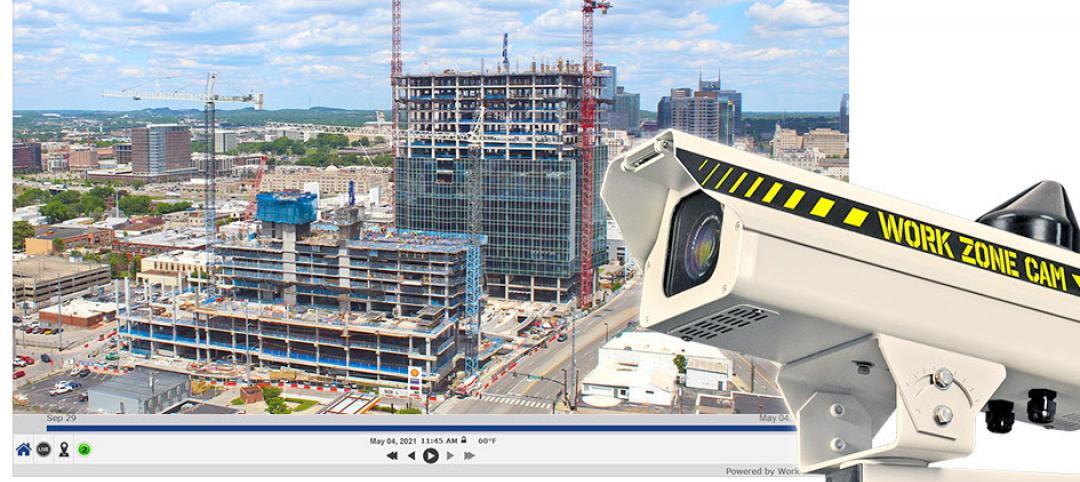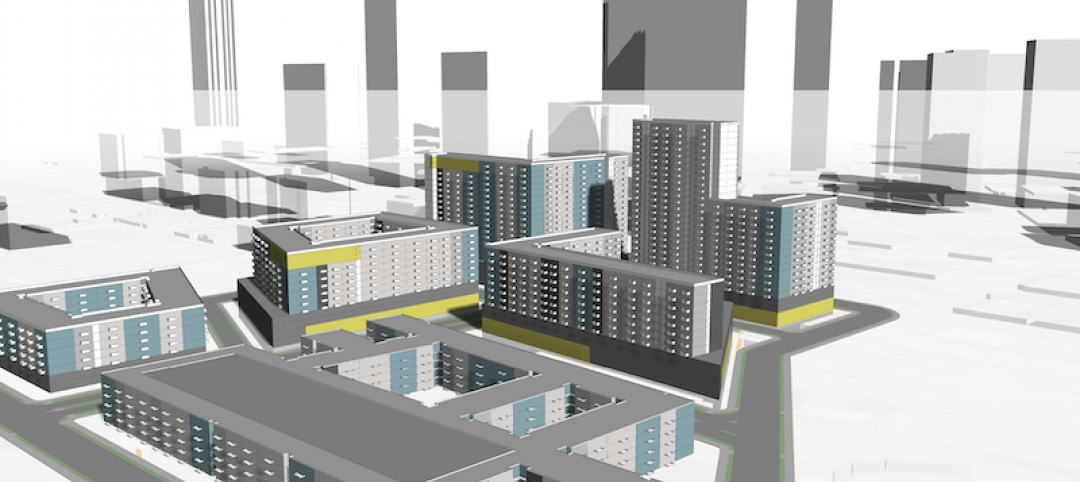The relationships between buildings and machines have always defined the fields of design and construction. More than 2,000 years ago, in the first treatise on architecture, Vitruvius dedicated all of the final volume to machines. Since then, arguably the entire history of construction has centered on the movement away from handicraft toward progressive degrees of mechanization. Today, mechanization, the replacement of hand labor, is increasingly giving way to automation, the replacement of human labor altogether.
Below are four fundamental relationships between buildings and machines. As automation becomes more prominent, it is changing these relationships dramatically.
Machines in Buildings
Over the past century or two, new mechanisms have fundamentally redefined the possibilities of buildings. After Elisha Otis invented the safety elevator in 1852, buildings could climb well beyond a comfortable walk-up height, and the skyscraper was born.
In 1902, Willis Carrier introduced modern air conditioning, which allowed floor plates to get deeper (spurring a century of energy hogging). The bimetallic thermostat, an example of automation dating from the 1880s, long has been a staple in homes and offices everywhere. Building automation systems (BAS) apply this concept systemwide, with internal feedback adjusting HVAC and lighting to improve comfort, security, energy consumption, maintenance, and operating costs.
The Internet of Things (IoT) connects computers embedded in everyday objects, including buildings, to expand these feedback loops beyond the immediate building to the entire world. Over the next few years alone, instances of IoT are expected to double in commercial real estate. Buildings are coming to be defined less as static objects and more as completely fluid environments.
Machines for Building
Ancient structures were assembled with a few simple tools, and the oldest may have used none at all. Possibly the earliest known “constructions,” during the Stone Age, were made of Mammoth bones lashed together to form huts. With the agricultural revolution, communities became less nomadic, and buildings became less portable, leading to heavier construction and the need for more powerful tools.
The industrial revolution catapulted whole industries and economies with mass-produced timber and steel. The history of construction since then has been propelled by leveraging more and more force, and today gigantic machines for digging and lifting dominate large construction sites.
But emerging automated techniques could return building fabrication to its origins in lightweight assembly methods. Homes are being 3D printed in 24 hours at a fraction of the expense of traditional construction. Bricklaying robots can assemble a wall at half the cost and 3-5 times the productivity. Soon, clouds of flying assembler drones could become the norm, making construction sites buzz and thrum like beehives or ant hills.
Buildings as Machines
“A house is a machine for living in,” Le Corbusier famously declared in 1929, and the mechanical metaphor became a foundational premise of modern architecture. Later, the machine aesthetic became more explicit. The Centre Pompidou in Paris (1977) wore its systems on its sleeve, the primary architectural expression coming from equipment, ductwork, and conveying systems.
But metaphor could soon become reality. Nanotechnology, originally proposed by Nobel physicist Richard Feynman half a century ago, manipulates individual atoms and molecules to build things—anything. Already, researchers have successfully experimented with nanotech in concrete and steel, strengthening materials and improving performance by adjusting automatically to offset stress and strain.
‘Buildings are coming to be defined less as static objects and more as
completely fluid environments.’ — Lance Hosey, FAIA, LEED Fellow, Gensler
Experts anticipate that within the next few decades, whole buildings could be fabricated using microscopic robots, which would join to make a cybernetic glue, eliminating traditional material constraints. Standard, irreducible components, such as the 2x4, the brick, and steel shapes, could be replaced by microscopic parts, and form, texture, color, and strength could be defined at the cellular level.
Orthogonal geometry, demanded for efficiency by standard frame construction, could disappear altogether. A century ago, Frank Lloyd Wright described “organic architecture” as “building the way nature builds.” Nanotech could finally bring this to fruition.
By modifying themselves over successive generations, ebbing and flowing in endless cycles of reproduction and adaptation, nano-assemblers could produce architecture through a process similar to genetic evolution—only faster—and therefore build exactly the way nature builds.
Buildings by and for Machines
In previous articles in this series, we’ve explored the implications of artificial intelligence. Futurist Ray Kurzweil predicts that machines will achieve human-level intelligence within a decade, and this will affect every industry, including our own.
If and when AI drives the entire process of design, construction, and operation, buildings could become exponentially smarter with resources, money, time, and performance, creating environments more engaging and comforting than we can imagine right now.
Yet, Kurzweil also anticipates that within a century we will concede that machines have legal and civil rights. Will self-aware buildings become as privileged as their inhabitants? How will our relationship with buildings change if we begin to see them as our equals? Machines could become more like us, but we could become more like them, as well.
Kurzweil is certain that artificial enhancements of the human body will become more common until we are more synthetic than organic. It will become possible to scan the mind and download it into more durable or flexible containers—such as buildings. Dwelling and dweller could become one and the same.
Lance Hosey, FAIA, LEED Fellow, is a Design Director with Gensler. His book, The Shape of Green: Aesthetics, Ecology, and Design, has been an Amazon #1 bestseller in the Sustainability & Green Design category.
Related Stories
AEC Tech | Jul 14, 2021
Bjarke Ingels Group and UNStudio invest in SpaceForm, a virtual workspace for architects
Squint/Opera developed the platform in 2018.
AEC Tech | Jun 30, 2021
Orro Launches New Integration with Sonos, Providing Seamless In-Wall Control for Sonos Speakers
With the new integration, customers can use the dynamic display on Orro’s smart light switches to control their favorite audio content on their Sonos speakers.
AEC Tech | Jun 9, 2021
Orro Announces Unified Smart Home App
Orro app now provides control of other smart home devices from leading professional and consumer device manufacturers.
AEC Tech | Jun 8, 2021
FARO Expands Digital Twin Product Suite - Acquires HoloBuilder Inc.
FARO Technologies, a global leader of 3D measurement, imaging, and realization solutions for the 3D Metrology, AEC (Architecture, Engineering & Construction), and Public Safety Analytics markets, today announced the acquisition of HoloBuilder, Inc.
AEC Tech | May 27, 2021
New Work Zone Cam Pro Delivers 33% More Detail for Time-Lapse
Work Zone Cam, a leading provider of professional jobsite construction camera services, premiered its latest camera, which increases image resolution from 18 to 24 megapixels. The additional image detail helps track construction progress more accurately and results in higher resolution time-lapses for construction documentation.
Digital Twin | May 24, 2021
Digital twin’s value propositions for the built environment, explained
Ernst & Young’s white paper makes its cases for the technology’s myriad benefits.
AEC Tech | Apr 15, 2021
3 startups making their mark in 2021
Meet a trio of AEC tech firms that are making advances in the COVID-19 era.
Adaptive Reuse | Apr 15, 2021
The Weekly Show, Apr 15, 2021: The ins and outs of adaptive reuse, and sensors for real-time construction monitoring
This week on The Weekly show, BD+C editors speak with AEC industry leaders from PBDW Architects and Wohlsen Construction about what makes adaptive reuse projects successful, and sensors for real-time monitoring of concrete construction.
AEC Tech | Apr 8, 2021
The Weekly Show, April 8, 2021: SPOT the autonomous robot, and Woods Bagot's in-house 'futurist'
This week on The Weekly show, BD+C editors speak with AEC industry leaders from Procon Consulting, Virginia Tech, and Woods Bagot about SPOT, the autonomous robot for construction progress monitoring applications, and how Woods Bagot's new "futurist" is promoting innovation at the international design firm.
Coronavirus | Mar 11, 2021
The Weekly show, March 11, 2021: 5 building products for COVID-related conditions, and AI for MEP design
This week on The Weekly show, BD+C editors speak with AEC industry leaders about building products and systems that support COVID-related conditions, and an AI tool that automates the design of MEP systems.

















